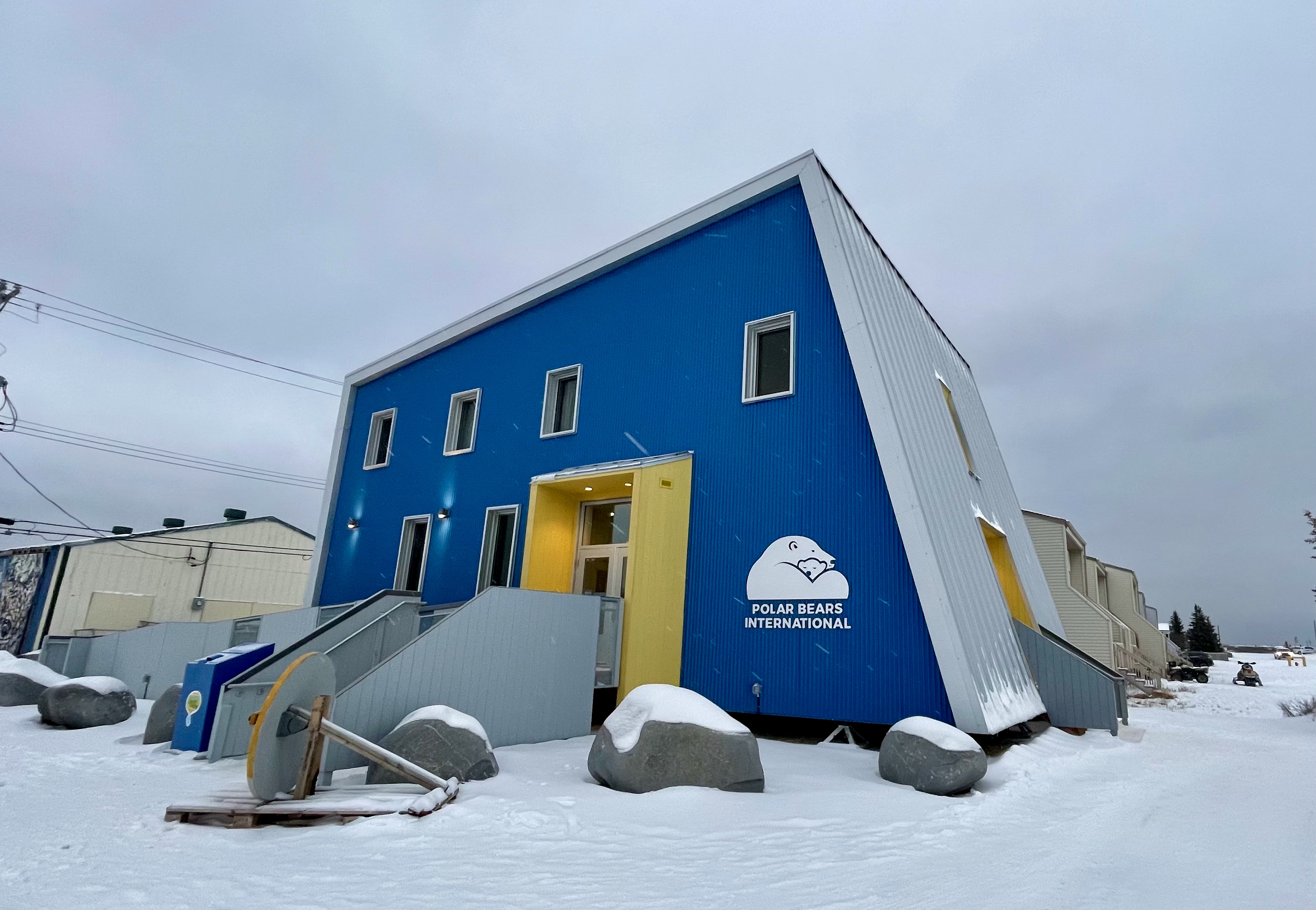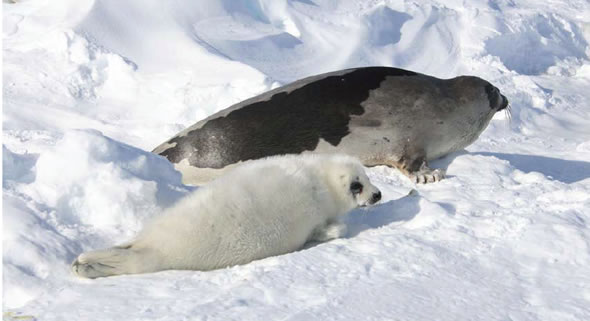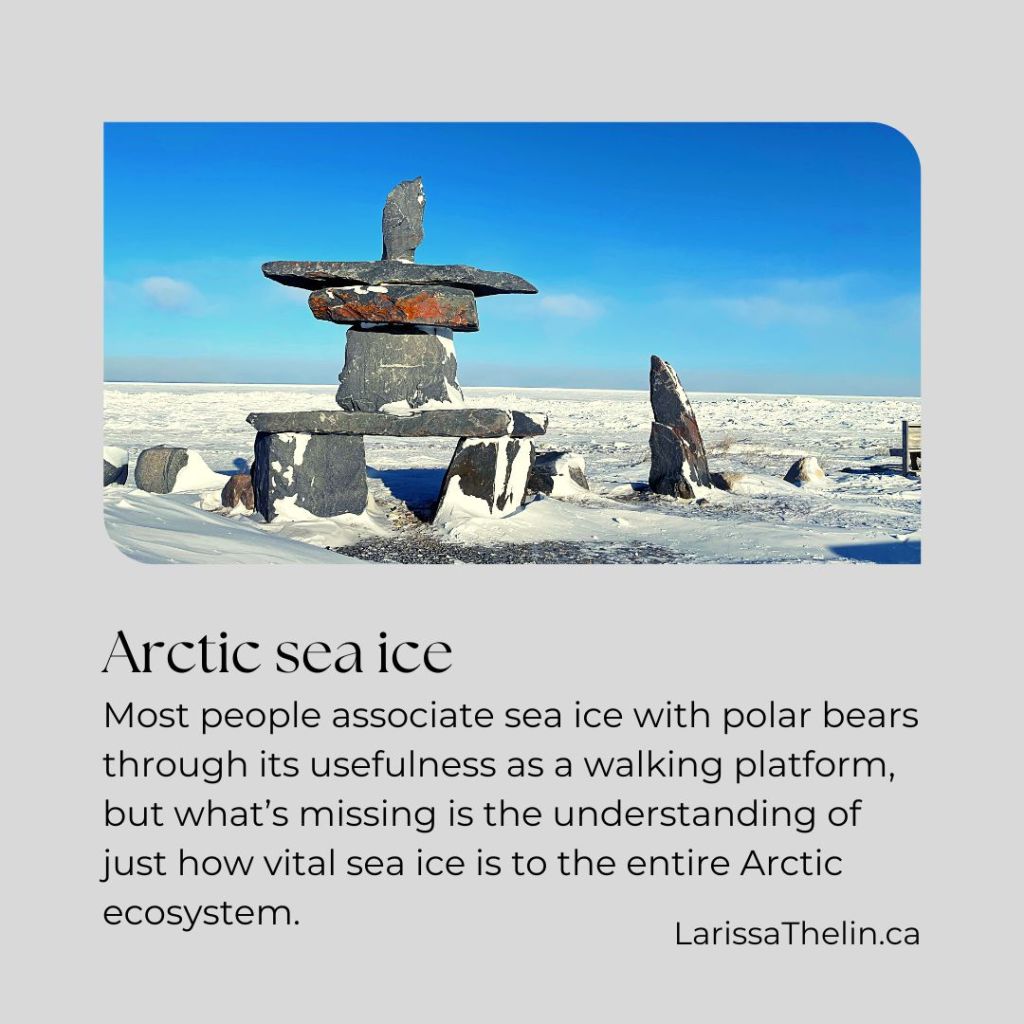This Friday (July 15) marks Arctic Sea Ice Day, a day created by Polar Bears International to draw attention to the Arctic sea ice environment and how climate change is affecting it. When talking with the public about this topic, I’ve noticed that most people associate sea ice with polar bears through its usefulness as a walking platform. They understand that polar bears need the sea ice to walk on to access seals. So, when climate change is brought up, I often get questions like “why can’t bears just swim to hunt?” or “why can’t they just hunt for other things on land?”. Putting aside the metabolic requirements of polar bears that requires a diet of seal blubber1 and the fact that swimming to hunt is very calorie intensive (meaning they would need to hunt much more) and therefore not cost-effective2, what’s missing is the understanding of just how vital sea ice is to the entire Arctic ecosystem, not just polar bears.
At Polar Bears International House there is a quote on the wall that we often refer to: sea ice is to the Arctic what soil is to the forest. Think of how soil is the substrate from which all life in the forest forms: primary producers (plants) grow from the soil, which feed secondary producers (herbivores), who then go on to feed tertiary consumers (omnivores and carnivores). Without the soil for the plants to grow from, nothing else in the forest would exist. Now flip that image upside down and you have a basic understanding of how Arctic sea ice works.


Polar Bears International House (left), which houses the Interpretive Centre (right), a public space where people can learn about polar bears and Climate Change. On the right I am presenting to a group of tourists about the sea ice ecosystem.
Because sea ice is made of frozen sea water, within the sea ice itself is salt. As sea ice freezes, this salt will expel from the ice over time causing channels to form within the ice3,4. When sea ice is the perfect thickness for sunlight to reach the newly-formed channels, sea ice algae will form within them3. These algae, also known as phytoplankton, are the primary producers of the entire Arctic food web4,5. As the salt expels from the sea ice it creates dense, salty water that sinks to the ocean floor, forcing water from the bottom to move upwards, bringing with it a plethora of nutrients5. The combination of nutrient-rich water and algae-filled sea ice creates a space for biodiversity in the Arctic to flourish. Small critters, such as zooplankton, eat the algae, who in turn feed fish, such as the Arctic cod4,5. Without fish to eat, seals would have no reason to be beneath the sea ice4. And where we find seals, we find polar bears. Even if polar bears could transition to hunting in water full-time, the issue is that without sea ice there would be nothing to hunt. In short, what to us appears as a blank white landscape actually hides an abundance of life beneath the surface.


A polar bear (left; photograph by Dr. Andrew Derocher) and harp seals (right; photograph by Department of Fisheries and Oceans Canada) on Arctic sea ice.
But this blank white landscape is also important as a platform, and not just for polar bears to walk on. For many Arctic seal species, sea ice is absolutely vital for many aspects of their life history. They use it as a platform for breeding, moulting (when they shed old fur and replace it with new fur), raising their pups, or even just as a resting spot between swimming sessions4,6. Harp seals in particular (one of my study species) entirely depends on sea ice for the first six weeks of their life – they’re simply too young to be able to swim yet7,8. Many other species, such as belugas, narwhals, and walruses, also depend on sea ice in some way and research has shown that some are already being negatively impacted by a loss in sea ice over recent decades9-12.



Me standing on sea ice for the first time in Churchill, Manitoba.
As if this wasn’t enough to convince us to preserve sea ice, it also has one of the most vital roles in managing Earth’s temperature – something we should consider crucial in our fight against climate change. Arctic sea ice acts as Earth’s air conditioner. Because sea ice is light-coloured, it reflects the sun’s energy away from the surface13-15. This is explained through the theory of albedo, where lighter colours reflect more of the sun’s energy than darker colours14. Since sea ice is so bright, it can reflect from 50-70% of the sunlight that reaches it14. When that ice melts, it’s replaced by ocean water, which has a much darker colour that absorbs heat rather than reflects it15. Essentially, when we lose our polar ice caps, we lose the lightest-coloured surface on Earth, the very thing helping to keep our climate cool.
When we lose sea ice, we lose the “soil” of the Arctic, which causes cascading effects across the entire Arctic ecosystem. We also lose the habitat of numerous Arctic species. Further, the ability for the Earth to regulate its temperature is hindered. I cannot stress how serious the loss of Arctic sea ice is; it affects the health of our entire planet. It is therefore astounding that governments are not taking the necessary action to save sea ice by mitigating climate change. But we can all help by learning more about climate change and sea ice, and by discussing these issues with our friends and family.

Hudson Bay (Churchill, Manitoba) full of sea ice in mid-February, with an Inuit Inukshuk in the foreground.
Sources
- Polar Bears International. (n.d.). Diet & prey.
- Pagano, A. (2021). Polar bears expend more energy in a melting Arctic.
- Polar Bears International. (2022). Key facts about Arctic sea ice.
- Galicia, M. (2019). The importance of sea ice: from phytoplankton to polar bears.
- National Snow & Ice Data Centre. (2020). Wildlife: Phytoplankton.
- National Snow & Ice Data Centre. (2020). Wildlife: Seals.
- Smithsonian. (2013). Ice-loving seals and the loss of sea ice.
- NOAA Fisheries. (n.d.). Harp seal.
- Laidre, K.L., et al. (2015). Arctic marine mammal population status, sea ice habitat loss, and conservation recommendations for the 21st century. Conservation Biology, 29(3), 724-737.
- World Wildlife Foundation. (2018). Climate change puts the Pacific walrus population on thin ice.
- World Wildlife Foundation. (2021). Why narwhal are most vulnerable to a warmer, louder Arctic.
- McCall, A. (2019). Sea ice: the beluga’s protector.
- NASA. (n.d.). Sea ice.
- National Snow & Ice Data Centre. (2020). Thermodynamics: Albedo.
- National Snow & Ice Data Centre. (n.d.). Quick facts on Arctic sea ice.
Additional Information
- Learn more about this issue using Polar Bears International’s Arctic Sea Ice Day Toolkit
- See my Resources page to learn more about climate change and how to help
- Click the links throughout this post for more information (black text links to other webpages)

2 responses to “Arctic sea ice”
[…] rhetoric to the contrary, there is still plenty of sea ice over Arctic regions this summer, supplying feeding platforms for […]
LikeLike
I’ve approved this comment on my blog post to prove a point. For those interested, this person left me 5 separate comments (each from unique fake accounts) all with links to this same blog post that they wrote in response to mine. I want to clarify two things. One, if you are going to argue something I’ve written, be sure to provide peer-reviewed or scholarly sources, as I have done. In this post alone I have 15 separate citations from 6 different legitimate organizations as well as over 4 scientists. I was being very scarce with my citations here – I would be happy to provide more. Second, this blog post linked above was written by Susan Crockford. Susan is a very well-known climate change denier, even earning herself an article by The New York Times that refers to her as “a primary source of dubious information about the status of polar bears”. She falsifies information and spreads it, actively making it harder for legitimate scientists to do their work.
Susan, I’m glad I have your attention. It means I’m successfully beginning to spread awareness of climate change, my life’s purpose. All future responses to my posts will not be tolerated.
See the NY Times article here: https://www.nytimes.com/2018/04/10/climate/polar-bears-climate-deniers.html
LikeLike